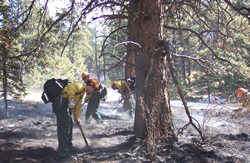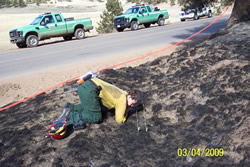
National Fire Plan Success Story
Fuel Treatments Help Contain Fossil Beds Wildfire
Florissant Fossil Beds National Monument, Colorado
National Fire Plan - Fuels Reduction
2009

Firefighters work to contain the Fossil Beds Fire.

Investigating possible cause of Fossil Beds Fire.
In the world of fire management, it is often hard to measure the success of many of the mitigation projects that are completed, unless they are actually tested by wildfire. That was the case in March 2009 at Colorado’s Florissant Fossil Beds National Monument when a human-caused wildfire was slowed and contained when it entered an area that had had numerous fuel reduction projects conducted there.
On March 3, 2009, a wildfire fire was reported in the southeast corner of the monument. This wind driven wildfire was pushing it toward the park boundary and structures and private property on the other side. A quick response and cooperative effort from the Teller County Emergency Management, National Park Service firefighters, the U.S. Forest Service from Lake George and other local agencies were able to contain the Fossil Bed Fire to 41 acres by the end of the next day. Investigation concluded that the fire had been caused by exhaust emissions from a passing vehicle.
A major factor in the firefighters’ successful efforts to contain the fire was some of the fuel reduction and thinning activities that had taken place along much of the monument’s boundary for the last several years. This reduction in fuels caused the fire’s activity level to be reduced enabling firefighters the opportunity to contain the fire quickly in spite of dry, windy conditions. The probability of the fire spreading to private property and structures adjacent to the park would have been far greater had the mitigation measures not taken place.
Community support for the monument’s fuel reduction program has been and will remain vital to helping lower the risk from a catastrophic fire event. The successful containment of the vast majority of the Fossil Bed Fire to within the monument (less than1/2 acre burned on private land) is a good example of how fire mitigation efforts can slow or stop the movement of a fire by eliminating the fuels the fire needs.
Due to the efforts over the last few years, Florissant Fossil Bed’s fire management program has helped to reduce the risk from wildfire to local landowners and residents. Continued fuel reduction efforts in the future will only help to reduce the risk even more. Local residents are not only safer in the event of a wildfire, they will also get to witness the burned area recover in the spring with a forest intact and a flush of new grasses for the abundant elk herd roaming the monument.
Contact: Shawn Frizzel, Interpreter, or Mike Lewelling, Fire Management Officer, (719) 748-3253 or (970) 586-1287.